University Essay: Gender Differences in Communication Analysis
VerifiedAdded on 2022/08/09
|6
|1382
|261
Essay
AI Summary
This essay investigates gender differences in communication, starting from childhood influences and their impact on interaction styles. It argues that significant communication disparities exist between genders, affecting society. The discussion covers 'report talk' versus 'rapport talk,' highlighting how men focus on content and factual information while women prioritize relationships. The essay examines instrumental versus expressive communication styles and how these differences influence leadership, with women often demonstrating strong collaborative skills and rising in corporate leadership roles. Furthermore, it explores how men use conversation for maintaining status and women for negotiating closeness, and how these differences affect business and societal dynamics, including the rise of women entrepreneurs. The conclusion emphasizes the increasing presence of women in leadership and their strategic use of communication.
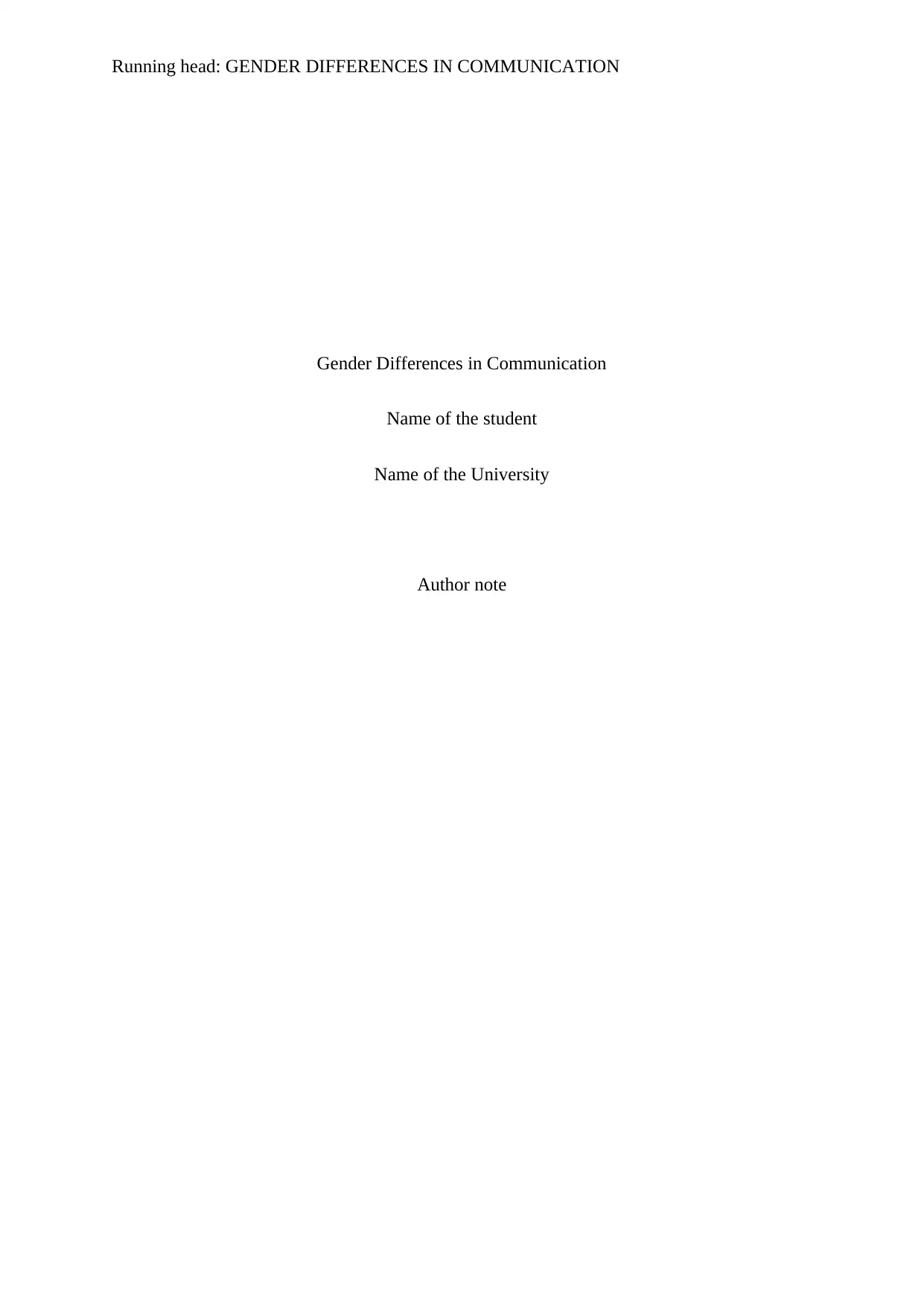
Running head: GENDER DIFFERENCES IN COMMUNICATION
Gender Differences in Communication
Name of the student
Name of the University
Author note
Gender Differences in Communication
Name of the student
Name of the University
Author note
Paraphrase This Document
Need a fresh take? Get an instant paraphrase of this document with our AI Paraphraser
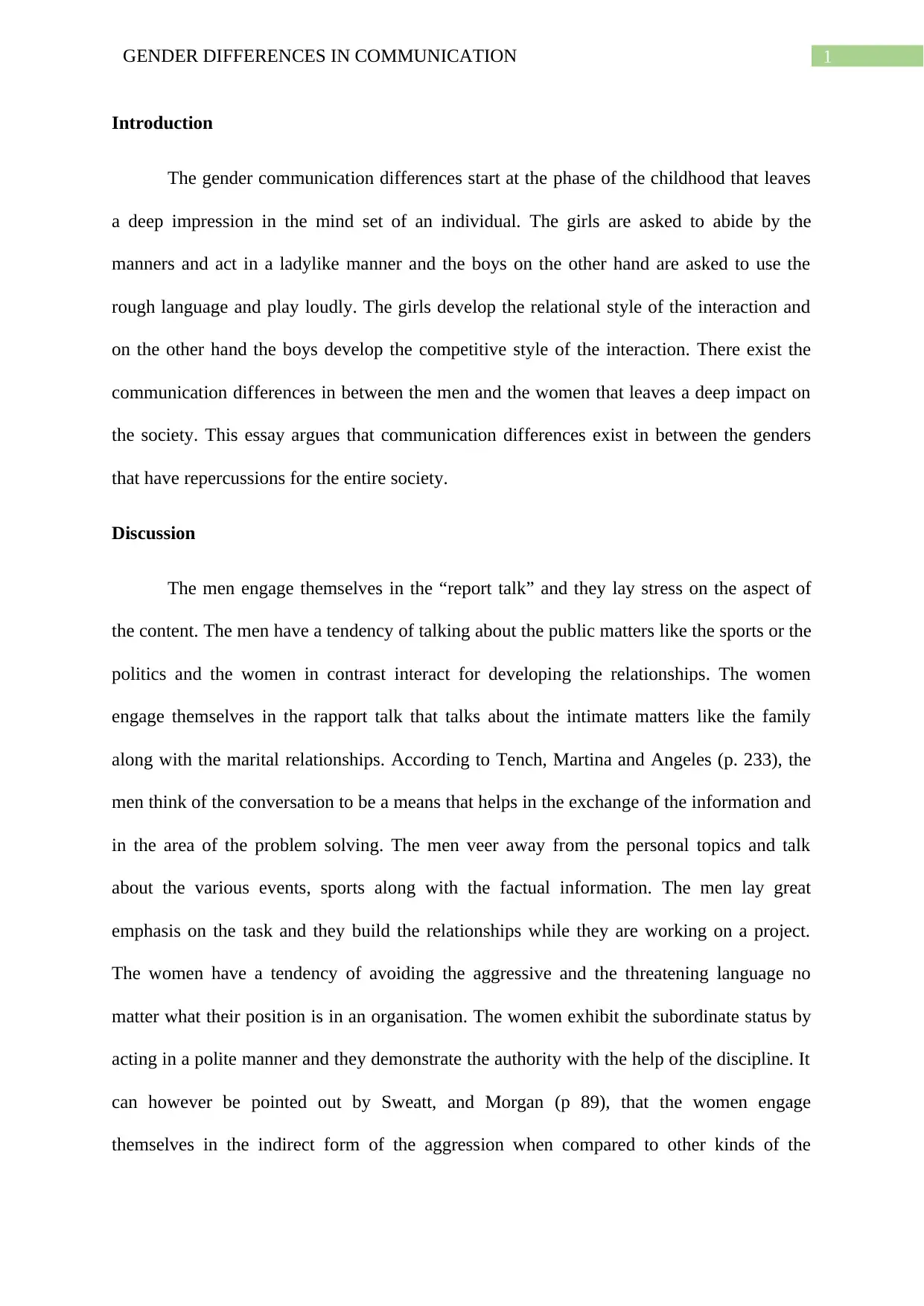
1GENDER DIFFERENCES IN COMMUNICATION
Introduction
The gender communication differences start at the phase of the childhood that leaves
a deep impression in the mind set of an individual. The girls are asked to abide by the
manners and act in a ladylike manner and the boys on the other hand are asked to use the
rough language and play loudly. The girls develop the relational style of the interaction and
on the other hand the boys develop the competitive style of the interaction. There exist the
communication differences in between the men and the women that leaves a deep impact on
the society. This essay argues that communication differences exist in between the genders
that have repercussions for the entire society.
Discussion
The men engage themselves in the “report talk” and they lay stress on the aspect of
the content. The men have a tendency of talking about the public matters like the sports or the
politics and the women in contrast interact for developing the relationships. The women
engage themselves in the rapport talk that talks about the intimate matters like the family
along with the marital relationships. According to Tench, Martina and Angeles (p. 233), the
men think of the conversation to be a means that helps in the exchange of the information and
in the area of the problem solving. The men veer away from the personal topics and talk
about the various events, sports along with the factual information. The men lay great
emphasis on the task and they build the relationships while they are working on a project.
The women have a tendency of avoiding the aggressive and the threatening language no
matter what their position is in an organisation. The women exhibit the subordinate status by
acting in a polite manner and they demonstrate the authority with the help of the discipline. It
can however be pointed out by Sweatt, and Morgan (p 89), that the women engage
themselves in the indirect form of the aggression when compared to other kinds of the
Introduction
The gender communication differences start at the phase of the childhood that leaves
a deep impression in the mind set of an individual. The girls are asked to abide by the
manners and act in a ladylike manner and the boys on the other hand are asked to use the
rough language and play loudly. The girls develop the relational style of the interaction and
on the other hand the boys develop the competitive style of the interaction. There exist the
communication differences in between the men and the women that leaves a deep impact on
the society. This essay argues that communication differences exist in between the genders
that have repercussions for the entire society.
Discussion
The men engage themselves in the “report talk” and they lay stress on the aspect of
the content. The men have a tendency of talking about the public matters like the sports or the
politics and the women in contrast interact for developing the relationships. The women
engage themselves in the rapport talk that talks about the intimate matters like the family
along with the marital relationships. According to Tench, Martina and Angeles (p. 233), the
men think of the conversation to be a means that helps in the exchange of the information and
in the area of the problem solving. The men veer away from the personal topics and talk
about the various events, sports along with the factual information. The men lay great
emphasis on the task and they build the relationships while they are working on a project.
The women have a tendency of avoiding the aggressive and the threatening language no
matter what their position is in an organisation. The women exhibit the subordinate status by
acting in a polite manner and they demonstrate the authority with the help of the discipline. It
can however be pointed out by Sweatt, and Morgan (p 89), that the women engage
themselves in the indirect form of the aggression when compared to other kinds of the
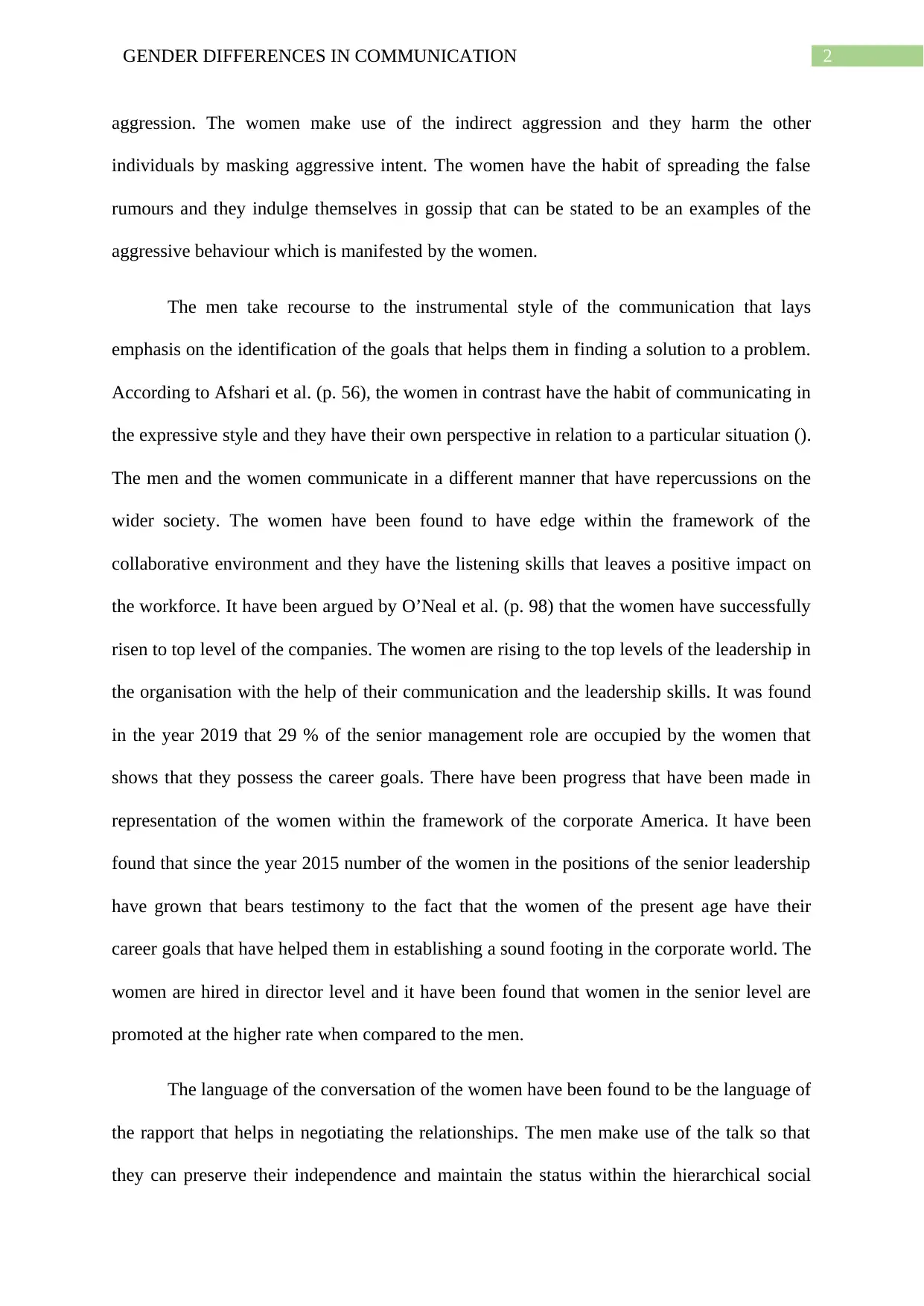
2GENDER DIFFERENCES IN COMMUNICATION
aggression. The women make use of the indirect aggression and they harm the other
individuals by masking aggressive intent. The women have the habit of spreading the false
rumours and they indulge themselves in gossip that can be stated to be an examples of the
aggressive behaviour which is manifested by the women.
The men take recourse to the instrumental style of the communication that lays
emphasis on the identification of the goals that helps them in finding a solution to a problem.
According to Afshari et al. (p. 56), the women in contrast have the habit of communicating in
the expressive style and they have their own perspective in relation to a particular situation ().
The men and the women communicate in a different manner that have repercussions on the
wider society. The women have been found to have edge within the framework of the
collaborative environment and they have the listening skills that leaves a positive impact on
the workforce. It have been argued by O’Neal et al. (p. 98) that the women have successfully
risen to top level of the companies. The women are rising to the top levels of the leadership in
the organisation with the help of their communication and the leadership skills. It was found
in the year 2019 that 29 % of the senior management role are occupied by the women that
shows that they possess the career goals. There have been progress that have been made in
representation of the women within the framework of the corporate America. It have been
found that since the year 2015 number of the women in the positions of the senior leadership
have grown that bears testimony to the fact that the women of the present age have their
career goals that have helped them in establishing a sound footing in the corporate world. The
women are hired in director level and it have been found that women in the senior level are
promoted at the higher rate when compared to the men.
The language of the conversation of the women have been found to be the language of
the rapport that helps in negotiating the relationships. The men make use of the talk so that
they can preserve their independence and maintain the status within the hierarchical social
aggression. The women make use of the indirect aggression and they harm the other
individuals by masking aggressive intent. The women have the habit of spreading the false
rumours and they indulge themselves in gossip that can be stated to be an examples of the
aggressive behaviour which is manifested by the women.
The men take recourse to the instrumental style of the communication that lays
emphasis on the identification of the goals that helps them in finding a solution to a problem.
According to Afshari et al. (p. 56), the women in contrast have the habit of communicating in
the expressive style and they have their own perspective in relation to a particular situation ().
The men and the women communicate in a different manner that have repercussions on the
wider society. The women have been found to have edge within the framework of the
collaborative environment and they have the listening skills that leaves a positive impact on
the workforce. It have been argued by O’Neal et al. (p. 98) that the women have successfully
risen to top level of the companies. The women are rising to the top levels of the leadership in
the organisation with the help of their communication and the leadership skills. It was found
in the year 2019 that 29 % of the senior management role are occupied by the women that
shows that they possess the career goals. There have been progress that have been made in
representation of the women within the framework of the corporate America. It have been
found that since the year 2015 number of the women in the positions of the senior leadership
have grown that bears testimony to the fact that the women of the present age have their
career goals that have helped them in establishing a sound footing in the corporate world. The
women are hired in director level and it have been found that women in the senior level are
promoted at the higher rate when compared to the men.
The language of the conversation of the women have been found to be the language of
the rapport that helps in negotiating the relationships. The men make use of the talk so that
they can preserve their independence and maintain the status within the hierarchical social
⊘ This is a preview!⊘
Do you want full access?
Subscribe today to unlock all pages.

Trusted by 1+ million students worldwide
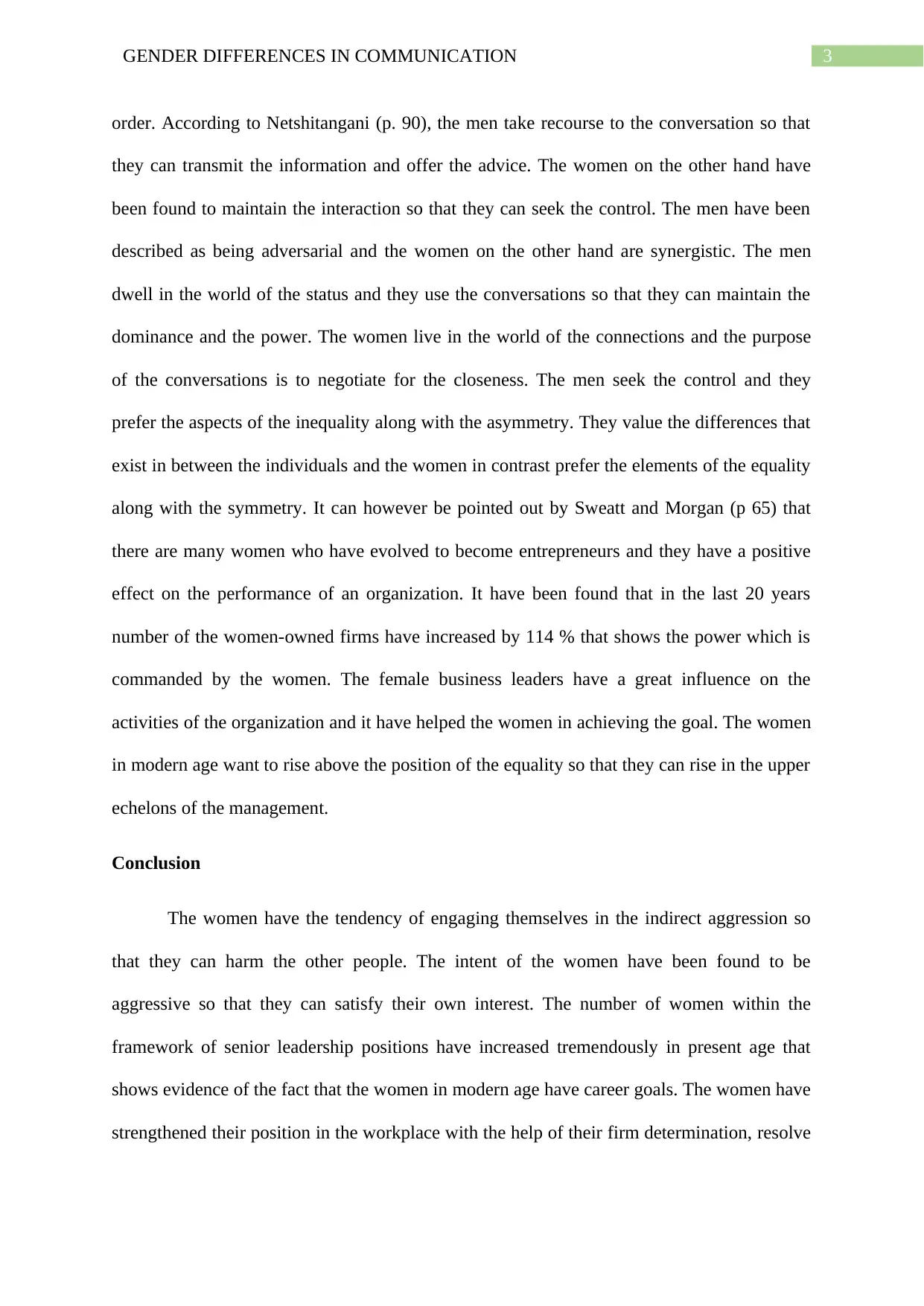
3GENDER DIFFERENCES IN COMMUNICATION
order. According to Netshitangani (p. 90), the men take recourse to the conversation so that
they can transmit the information and offer the advice. The women on the other hand have
been found to maintain the interaction so that they can seek the control. The men have been
described as being adversarial and the women on the other hand are synergistic. The men
dwell in the world of the status and they use the conversations so that they can maintain the
dominance and the power. The women live in the world of the connections and the purpose
of the conversations is to negotiate for the closeness. The men seek the control and they
prefer the aspects of the inequality along with the asymmetry. They value the differences that
exist in between the individuals and the women in contrast prefer the elements of the equality
along with the symmetry. It can however be pointed out by Sweatt and Morgan (p 65) that
there are many women who have evolved to become entrepreneurs and they have a positive
effect on the performance of an organization. It have been found that in the last 20 years
number of the women-owned firms have increased by 114 % that shows the power which is
commanded by the women. The female business leaders have a great influence on the
activities of the organization and it have helped the women in achieving the goal. The women
in modern age want to rise above the position of the equality so that they can rise in the upper
echelons of the management.
Conclusion
The women have the tendency of engaging themselves in the indirect aggression so
that they can harm the other people. The intent of the women have been found to be
aggressive so that they can satisfy their own interest. The number of women within the
framework of senior leadership positions have increased tremendously in present age that
shows evidence of the fact that the women in modern age have career goals. The women have
strengthened their position in the workplace with the help of their firm determination, resolve
order. According to Netshitangani (p. 90), the men take recourse to the conversation so that
they can transmit the information and offer the advice. The women on the other hand have
been found to maintain the interaction so that they can seek the control. The men have been
described as being adversarial and the women on the other hand are synergistic. The men
dwell in the world of the status and they use the conversations so that they can maintain the
dominance and the power. The women live in the world of the connections and the purpose
of the conversations is to negotiate for the closeness. The men seek the control and they
prefer the aspects of the inequality along with the asymmetry. They value the differences that
exist in between the individuals and the women in contrast prefer the elements of the equality
along with the symmetry. It can however be pointed out by Sweatt and Morgan (p 65) that
there are many women who have evolved to become entrepreneurs and they have a positive
effect on the performance of an organization. It have been found that in the last 20 years
number of the women-owned firms have increased by 114 % that shows the power which is
commanded by the women. The female business leaders have a great influence on the
activities of the organization and it have helped the women in achieving the goal. The women
in modern age want to rise above the position of the equality so that they can rise in the upper
echelons of the management.
Conclusion
The women have the tendency of engaging themselves in the indirect aggression so
that they can harm the other people. The intent of the women have been found to be
aggressive so that they can satisfy their own interest. The number of women within the
framework of senior leadership positions have increased tremendously in present age that
shows evidence of the fact that the women in modern age have career goals. The women have
strengthened their position in the workplace with the help of their firm determination, resolve
Paraphrase This Document
Need a fresh take? Get an instant paraphrase of this document with our AI Paraphraser

4GENDER DIFFERENCES IN COMMUNICATION
and their energy. The women business leaders want the power of the control so that they can
achieve the goal in company.
and their energy. The women business leaders want the power of the control so that they can
achieve the goal in company.
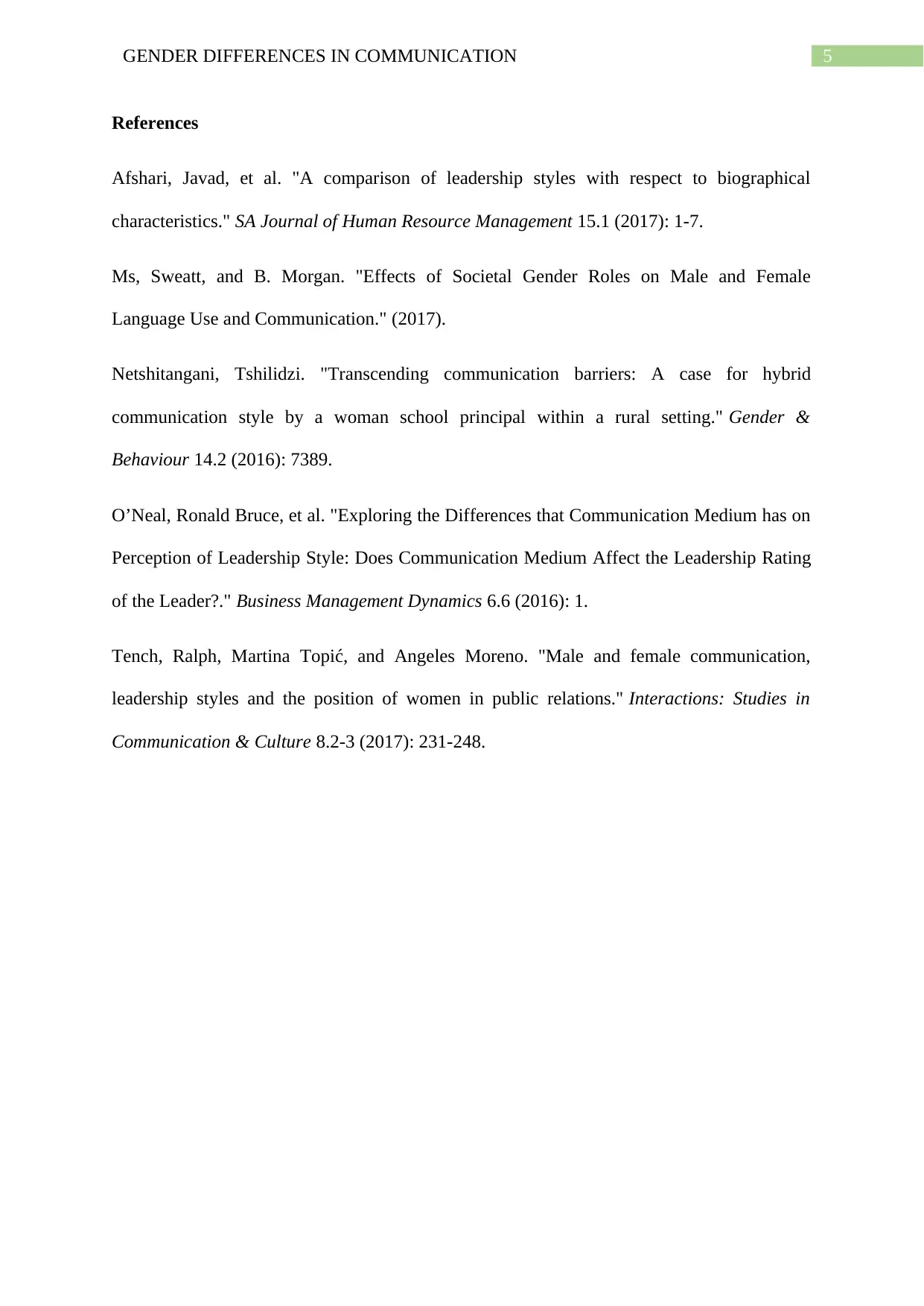
5GENDER DIFFERENCES IN COMMUNICATION
References
Afshari, Javad, et al. "A comparison of leadership styles with respect to biographical
characteristics." SA Journal of Human Resource Management 15.1 (2017): 1-7.
Ms, Sweatt, and B. Morgan. "Effects of Societal Gender Roles on Male and Female
Language Use and Communication." (2017).
Netshitangani, Tshilidzi. "Transcending communication barriers: A case for hybrid
communication style by a woman school principal within a rural setting." Gender &
Behaviour 14.2 (2016): 7389.
O’Neal, Ronald Bruce, et al. "Exploring the Differences that Communication Medium has on
Perception of Leadership Style: Does Communication Medium Affect the Leadership Rating
of the Leader?." Business Management Dynamics 6.6 (2016): 1.
Tench, Ralph, Martina Topić, and Angeles Moreno. "Male and female communication,
leadership styles and the position of women in public relations." Interactions: Studies in
Communication & Culture 8.2-3 (2017): 231-248.
References
Afshari, Javad, et al. "A comparison of leadership styles with respect to biographical
characteristics." SA Journal of Human Resource Management 15.1 (2017): 1-7.
Ms, Sweatt, and B. Morgan. "Effects of Societal Gender Roles on Male and Female
Language Use and Communication." (2017).
Netshitangani, Tshilidzi. "Transcending communication barriers: A case for hybrid
communication style by a woman school principal within a rural setting." Gender &
Behaviour 14.2 (2016): 7389.
O’Neal, Ronald Bruce, et al. "Exploring the Differences that Communication Medium has on
Perception of Leadership Style: Does Communication Medium Affect the Leadership Rating
of the Leader?." Business Management Dynamics 6.6 (2016): 1.
Tench, Ralph, Martina Topić, and Angeles Moreno. "Male and female communication,
leadership styles and the position of women in public relations." Interactions: Studies in
Communication & Culture 8.2-3 (2017): 231-248.
⊘ This is a preview!⊘
Do you want full access?
Subscribe today to unlock all pages.

Trusted by 1+ million students worldwide
1 out of 6
Your All-in-One AI-Powered Toolkit for Academic Success.
+13062052269
info@desklib.com
Available 24*7 on WhatsApp / Email
![[object Object]](/_next/static/media/star-bottom.7253800d.svg)
Unlock your academic potential
Copyright © 2020–2025 A2Z Services. All Rights Reserved. Developed and managed by ZUCOL.


